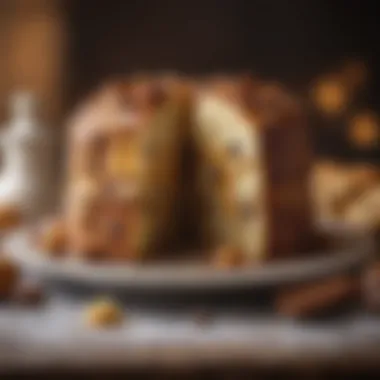Exploring the Italian Christmas Cake: Panettone Unveiled


Recipe Overview
Panettone: The Quintessential Italian Christmas Cake
Yield: 10 to 12 portions
Preparation Time: 30 minutes (plus 12-24 hours for dough rising)
Cooking Time: 45 minutes
Difficulty Level: Medium
Main Ingredients Used:
- Flour
- Sugar
- Butter
- Eggs
- Candied fruit (orange and lemon zest)
- Raisins
- Yeast
- Milk
Step-by-Step Instructions
1.
Prep Ingredients Before you start making Panettone, it is essential to prepare your ingredients.
- Start by measuring the required flour into a mixing bowl. Make sure it is high-quality bread flour for best results.
- In a separate bowl, mix yeast with warm milk and a pinch of sugar. Let it sit until it becomes frothy (about 10 minutes).
- Have candied fruits and raisins handy. Optionally, you can soak them in rum for extra flavor.
2.
Mixing the Dough Combine the flour, sugar, and salt in a large bowl. Create a well in the center, and add in your frothy yeast mixture, warmed milk, eggs, and softened butter. Mix until you achieve a shaggy dough.
3.
Kneading Knead on a floured surface for about 10-15 minutes. The dough should be smooth and elastic. If it is sticky, you can add a little more flour.
4.
First Rise Place the kneaded dough in a greased bowl and cover it with a clean cloth. Let it rise in a warm location until doubled in size. This can take about 2 hours.
5.
Shape and Fill After the first rise, punch the dough down and knead in the candied fruit and raisins. Shape it into a ball and place it into a Panettone mold or a tall paper baking form.
6.
Second Rise Cover the shaped dough with a cloth again. Let it rise for another 3-5 hours until it reaches the top of the mold.
7.
Baking Preheat your oven to 350°F (175°C). Bake for 40-45 minutes, or until golden brown. An inserted skewer should come out clean. Let it cool completely before slicing.
Nutritional Information
- Total Calories per Portion: Approximately 350 kcal
- Protein: 8g
- Fats: 15g
- Carbohydrates: 45g
Nutritional Benefits:
Panettone provides a substantial source of carbohydrates due to flour and sugar. The eggs enrich it with proteins and fats. Additionally, candied fruits add various vitamins and minerals, enhancing its antiquity.
Quick Cooking Tips
- Using Gadgets: A stand mixer can ease the kneading process, while using a proofing box can help create an optimal environment for dough rising.
- Effcient Cooking: Begin preparing other dishes while your Panettone rises. This helps to multitask your cooking.
- Shortcuts: For a quicker version, you can use a store-bought dough or even adjust for gluten-free flour if needed.
Related Recipes & Variations
For those who enjoy variations, try these complementary recipes:
- Italian Chocolate Cake: A rich counterpart to the light texture of Panettone.
- Ricotta Cheesecake: Offers a delicious blend with your Italian festive meals.
Dietary Adaptations: You can substitute sugar with honey for a more natural sweetness. For a different twist, use chocolate chips instead of fruits to match newer tastes.
Feel free to share any unique adaptations you have for your festive Panettone!


Intro to Italian Christmas Cake
The journey into Italian Christmas cake unfolds a rich tapestry of history, culture, and culinary art. This segment serves as the foundation, providing essential insights into what makes this festive cake significant. Understanding its definition and historical context brings forth a greater appreciation for its role within Italian celebrations.
Definition and Overview
Italian Christmas cake, often known as Panettone, is a sweet yeast bread typically enjoyed during the festive season in Italy and increasingly around the world. It is characterized by its tall, dome shape and a textured, airy crumb, often infused with delightful flavors such as candied citrus peel, dried fruits, and occasionally even chocolate or a splash of spirits. This cake captures the essence of Christmas gatherings, acting as a centerpiece on festive tables.
Historical Background
Origins in Italy
The origins of Panettone are steeped in tradition and folklore, tracing back to Milan during the early 15th century. It is believed that an Italian baker named Toni invented this cake inadvertently when trying to impress the nobility. Regarded as a popular choice, Panettone quickly became associated with the holiday season. The unique feature of the cake's method of preparation—using natural leavening—is still practiced today, ensuring that each version made retains its airy quality and delightful texture.
Evolution Over Centuries
Over the centuries, Panettone has undergone many transformations. Each region of Italy has added its twist, yielding variations that reflect local ingredients and preferences. The resurgence of interest in artisanal techniques in the late 20th century underscores a renaissance of authentic production methods, with high-quality ingredients becoming a standard. This evolution has contributed to Panettone's standing on a global stage, transitioning from a national treat to an international dessert must-have during Christmas, albeit sometimes resulting in controversies around what constitutes “authentic” Panettone.
The allure of Italian Christmas cake lies not just in its taste, but in the stories it tells and the traditions it embodies.
As we dive deeper into the cultural significance, ingredients, and preparation methods, we unveil the multi-faceted nature of Italian Christmas cake, exploring why it continues to be a treasured symbol of holiday spirit.
The Cultural Significance of Panettone
Panettone is not just a traditional cake; it holds a place of reverence in Italian culture. The cake is often the centerpiece of Christmas celebrations, symbolizing festive spirit and the joy of family gatherings. Its rich history and unique characteristics make it a subject of interest not just for culinary enthusiasts but for anyone curious about Italian heritage. Understanding the cultural significance of Panettone allows one to appreciate its role not merely as food but as a transmitter of tradition.
Traditions Surrounding the Cake
Christmas Celebrations in Italy
During Christmas, Panettone features prominently in Italy's culinary customs. It is a tradition for families to share the cake during festive meals, fostering a sense of community and joy. This practice enhances the family gatherings, which are central to Italy's cultural identity. The key characteristic of this tradition is its ability to bring people together, create shared experiences, and reinforce family bonds. People often put effort into choosing or making their own Panettone. Even when bought from artisan bakers, the variety and quality reflect personal taste and regional pride.
Though delightful, this tradition comes with a unique feature. Families may have to compete with each other to bring the best Panettone to the table. This can possibly produce stress when sourcing the perfect cake or ensuring its homemade variations stand out. However, the advantages far outweigh disadvantages, as the essence of togetherness strengthens during the holiday season.
Symbolism of Panettone
Every ingredient of Panettone is laden with meaning. The fruit symbolizes abundance and goodwill; the slow fermentation signifies patience – a virtue treasured in Italian culture. The cake is a mighty symbol. Its dome shape represents prosperity and the passing of another year. With this symbolism, Panettone serves as a backdrop for hopes and dreams during the holiday season.
This representation in the festive context makes Panettone a beneficial concept for analysis in this article. Each slice shared brings with it a message of grace, unity, and appreciation of life’s treasures. In this sense, Panettone transforms from an edible item into a cultural artifact with deep roots in the hearts of Italians.
Regional Variations
Different Types Across Italy
Italy is a diverse country with distinct regions, and the variations of Panettone reflect this richness. From the original Milanese version with its candied fruits to Sicilian variations that may incorporate pistachios, the essentially high-quality ingredients remain a common thread. Aside from pride in local tastes, these variations reinforce the characteristics of those areas through different flavors and textures. Such variations are not merely about taste, they tell a story of place and legacy, contributing overall to the allure of the Italian Christmas experience.
This points to an interesting fact - folks can enjoy Panettone made in their specific region, which instills a sense of local pride and affection for their unique customs. However, navigating these choices can lead to confusion for people unfamiliar with Italian culinary traditions, but photogenic presentation continues to rise for the cakes, reinforcing their appeal.
Local Ingredients and Methods
The essence of Panettone lies significantly in the local ingredients and methods used during preparation. Regions take pride in their offerings, varying from flour sourced from local mills to regional dried fruits, which elevate each version of the cake. This practice allows regional bakers to innovate while maintaining traditional methods.
Sourcing high-quality, regional ingredients guarantees that each Panettone is a testament to respect for ingredients and their source. Such practices increase appreciation for the creation of this cake. It in a way connects food to community. Detractors might worry about the availability of local varieties abroad; however, making Panettone can be much the more rewarding as it brings the essence of Italy right into one's home kitchen, embodying activities that move beyond simply baking.
In summary, building knowledge around these cultural significances enhances our understanding of Panettone within Italian celebrations, showcasing how this cake does more than please the palate during festive meals - it nurtures traditions and relationships.
Ingredients Used in Italian Christmas Cake
Understanding the ingredients used in the Italian Christmas cake is crucial for grasping the essence of this delightful dessert. Each component not only adds flavor but also contributes to the cake's texture and overall quality. Selecting the right ingredients is essential for achieving authenticity and that comforting holiday spirit.
Key Ingredients


Flour and Yeast
Flour and yeast are foundational in creating the signature texture of the Italian Christmas cake. Flour provides structure, while yeast acts as a leavening agent, allowing the cake to rise. The ideal choice for this recipe is often all-purpose flour combined with bread flour, which gives a light and airy crumb. Using high-quality yeast can lead to better fermentation, enhancing both flavor and texture.
One key characteristic of flour and yeast is their ability to create that classic airy structure of Panettone. While many recipes rely on commercial live yeast, some artisan bakers may opt for natural sourdough, resulting in a depth of flavor unavailable in traditional methods. The challenge here is balancing the accuracy of measurements and the fermentation time to prevent under or over proofing the dough.
Butter and Sugar
Butter and sugar contribute significantly to the richness of the cake and its unique flavor profile. Butter not only enhances mouthfeel but also adds moisture, while sugar helps in caramelization, yielding a warm, sweet crust. Generally, unsalted butter is preferred to allow for better control over seasoning.
What sets butter and sugar apart is their sweet harmony in baking. Sugar affects browning, adding a delightful finish to the outer layer of the cake. However, caution must be exercised with sugar quantities, as too much can lead to a dense final product. The balance is critical to ensure the cake is both flavorful and light in texture.
Dried Fruits and Candied Peel
Dried fruits, such as raisins and sultanas, together with candied peel provide not just taste but also festive visual appeal to Panettone. These ingredients bring a natural sweetness, contrasting nicely with the rich buttery cake. Dried fruits must be plumped either in warm water or rum, as this enhances their softness and juiciness in the cake.
Their main characteristic is in the aromatic flavors they contribute, evoking a sense of celebration. However, selection matters here as well; quality dried fruits and homemade candied peels can result in superior taste over mass-produced versions, which might lack intensivity. Traditional recipes often call for specific types that add to regional identity and notion of authenticity.
Quality Considerations
Using High-Quality Ingredients
The emphasis on using high-quality ingredients cannot be overstated. Choosing premium flour, butter, and other essentials elevates the overall culinary experience. High-quality ingredients are fundamental to the creation of any culinary delight, particularly pasticceria.
Using organic options could also bring noticeable differences in aroma and flavor development. While they can sometimes be more costly, the investment often results in a distinctly better product. Plus, local farming advocates have noted enhancements to overall sustainability and support microbiomes when sourcing products closer to home.
Impact on Flavor and Texture
Ingredient quality directly impacts both flavor and texture. A cake made with high-grade butter yields a creamier flavor, while the choice of flour can result in different crumb structures. Taste heavily relies on ingredient purity and does not generally tolerate cheap substitutes well.
Each choice reflects a baker’s vision and commitment to quality. This inconsistency can result in significant variations across cakes, something that true culinary enthusiasts are quick to discern. Advantage lies in being conscientious, wise about ingredient selections, promoting culinary integrity.
Maintaining a focus on quality ingredients upholds the tradition and symbolizes respect toward culinary heritage.
The Process of Making Italian Christmas Cake
Understanding the process of making the Italian Christmas cake, most notably Panettone, is essential in fully appreciating this traditional culinary art. It not only combines various quality ingredients but also reflects the temporal commitment that goes into crafting a true festive delicacy. Mastery of this process enables a creator to understand not just the how, but also the why behind each step, yielding a result worth its effort.
Preparation Tips
Equipment Needed
To start the preparations for making Panettone, certain equipment is indispensable. Using appropriate tools can greatly aid in achieving a delightful cake. The key item is a large mixing bowl. It must be sturdy enough to handle heavy dough. A mixer, well, especially a stand mixer, is incredibly beneficial here. It saves wrist fatigue and blends ingredients more efficiently compared to manual methods
A thermometer also plays a crucial role. This device ensures that the liquid components are maintained at proper temperatures, encouraging yeast activation. A good baking mold, often a tall and cylindrical form, helps create Panettone's signature height and shape. This contributes to the even cooking of the cake.
Time Management for Busy Schedules
In today's fast-paced world, managing your time efficiently becomes crucial, especially during the holiday season. Organizing steps into a clear plan helps yield smoother results. Planning methods include dividing activities into short and manageable segments. For example, starting the dough a day before actual baking allows it to ferment properly overnight, ensuring rich flavors and texture.
Knowing how long different steps take is beneficial too. Batch proofing helps expand time and details can be paired effectively into your normal kitchen schedule. Following this plan will reduce pre-baking stress and make ad-hoc guest arrivals easier to navigate.
Baking Techniques
Mixing and Proofing
The process of mixing and proofing is fundamental to baking Panettone. During mixing, great attention must be given to merging the ingredients thoroughly. Various textures are involved, and combined accurately, each ingredient performs uniquely in the end product. Proofing, on the other hand, is the period where the protein and sugars activate in yeast communities. As carbon dioxide bubbles reach development small air gaps are generated, enhancing the cake's rise, softness, and flavor depth after baking. Cruc sports humidity layers during process helps yield results here.
This makes mixing and proofing not only a safe practice but also a recommended residential challenge for anyone seeking delicious outcomes in Panettone.
Baking Temperature and Time


Baking temperature sharply impacts outcomes achieved, similarly in pastries. When preparing Panettone, a lower oven setting, in the range of 350°F (about 175°C), is usually the best choice. It equals perfectly paced baking, considerably emerging differences when altering time elapses and moisture levels throughout cook periods. Precise temperature management prevents overbaking or underbaking, which could ruin inferiorities in moisture and flavor.
Simultaneously, timing has its role as vital as precise heat allowances. Observing when the Panettone reaches a pleasing golden color while poking a thermometer probe into centre before confirming full bake provides a crucial accuracy, averting unwarranted excuse on rushed pastries.
"The art of baking Panettone contains rich history and commitment, accurately mirroring cultures intertwined around it."
Contemporary Adaptations of Italian Christmas Cake
The concept of contemporary adaptations of the Italian Christmas cake, particularly known as Panettone, plays a vital role in connecting tradition with modern tastes. As culinary trends evolve, chefs and home bakers alike find themselves exploring new ways to reinvent familiar recipes. This section focuses on the specific modern variants of Panettone, examining the emergence of gluten-free options and inventive flavor combinations.
Modern Variants
Gluten-Free Options
Gluten-Free Options for Panettone respond to the growing dietary needs and sensitivity among consumers. Many individuals today are avoiding gluten, leading to a demand for baked goods that cater to this necessity. This adaptation is beneficial not only for those with celiac disease but also for health-conscious individuals looking for alternatives.
One unique feature of many gluten-free Panettone recipes is the incorporation of alternative flours like almond flour or rice flour. While these ingredients offer a different taste and texture, they may sometimes lack the traditional fluffiness associated with classic Panettone. Consideration must also be given to textures, as achieving the airy lightness relies heavily on careful techniques in mixing and proofing. Hence, while gluten-free options allow inclusivity, they sometimes need a testing phase to find that perfect recipe.
Flavor Innovations
Flavor Innovations in Panettone reflect the culinary creativity found in today's kitchens. Bakers are not limited to using only dried fruits, like sultanas or candied orange, but are now integrating exotic flavors. There are recipes that vary from earl-grey-infused cakes to chocolate and hazelnut variants. This adaptability adds freshness and appeal to traditional cake and can rejuvenate family gatherings.
A key characteristic of flavor innovations in Panettone is their adaptability to gastronomy trends. They go beyond the conventional fruit and skillfully blend sweet pairings with unexpected spices or savory elements. While this enables bakers to cater to diverse, ever-changing palates, some traditionalists might argue against deviating from the classic approach. A balance must be struck, as too much alteration can rob Panettone of its identity.
Incorporating into Current Culinary Trends
With increasing emphasis on innovative cuisine, Panettone finds its place in a broader culinary landscape. The ways in which Panettone is reimagined for use in desserts or paired with other festive foods further illustrate its adaptability.
Use in Desserts
Panettone is increasingly recognized for its versatility in desserts. Rather than merely serving it with coffee, culinary enthusiasts are implementing it in recipes such as trifle or mousse. This adaptation leverages the self-sufficient flavors of traditional Panettone while prolonging its holiday significance.
The unique feature of incorporating Panettone into desserts lies in its ability to partner with complementary elements. For instance, incorporating a touch of cream or fresh fruits elevates the dining experience. However, careful consideration must be applied, as not all flavor combinations honor the essence of Panettone.
Pairing with Other Festive Foods
Among the adaptations, pairing with other festive foods illustrates another modern aspect that enhances Panettone's value. It does not merely occupy its solitary position during holiday feasts; it fits well alongside cheeses, cured meats, and even wines — contributing to an intricate tasting experience.
Successful pairs, such as dolce and salato, are essential in crafting balance during meal celebrations. The inclusive characteristic also promotes an inviting table arrangement where guests discover pleasant surprises. On the downside, bold pairing choices can overshadow the delicate flavors of the cake, challenging the baker’s expertise to create harmonious contrasts.
Ultimately, contemporary adaptations of Panettone bridge new ideas while retaining an enduring essence, allowing bakers to participate in a vibrant food culture that reflects today’s dynamic culinary scene.
Epilogue: Embracing Tradition in Modern Cooking
The Italian Christmas cake, particularly Panettone, stands as a testament to culinary tradition, transporting us back to Italy's rich cultural roots. In this article, we explored its historical significance, distinctive regional styles, and preparation methods. Understanding and appreciating such traditions allows us to forge a deeper connection with food. Embracing these culinary customs in our modern cooking brings may benefits, not only enhancing our festive celebrations but also promoting a greater understanding of diverse cultures.
Traditions like making Panettone during Christmas serve an important role. They generate feelings of nostalgia and continuity, keeping family recipes alive through generations. Such culinary practices remind us of who we are and where we come from. A well-executed Panettone celebrates quality ingredients, labor, and a sense of history that directly ties to the passion of Italian culinary art.
Instructing the meaning behind food as tradition takes center stage on any festive occasion. Understanding how to make Panettone fosters that connection to Italian heritage and encourages us to innovate or recreate these recipes at home. Essentially, when we engage with food traditions, we keep them living rather than merely observing.
The Value of Tradition
Tradition in the culinary arts stands powerful. It teaches cooks and food lovers the foundational skills necessary to master classic recipes. When it comes to Panettone, the detailed process—from selecting the perfect flour to carefully proofing the dough—illustrates the necessity of weaving these intricate techniques into our cooking practices.
- Following traditional recipes provides insight into historical lifestyles and ingredients.
- Engaging with those recipes enriches not only our flavor palettes but also our understanding of the culture behind the meal.
- Many culinary techniques used within traditional recipes improve skills applicable to wider cooking contexts.
By learning about the traditional preparation of Panettone, modern cooks can infuse their beloved holiday durables with genuine Italian flavor while also understanding the values of patience and precision in baking. Therefore, tradition forms the truest basis for contemporary culinary inspirations.
Encouragement to Explore Italian Culinary Heritage
Exploring Italian culinary heritage is more than just a nostalgic endeavor. It offers possibilities for future innovation while respecting past conventions. As interest in diverse foods rises worldwide, venturing into Italian traditions presents a date-worthy challenge.
Partaking in the making of Panettone allows enthusiasts to:
- Gain practical skills and inspire creativity in the kitchen or during gatherings.
- Experiment with flavors and incorporate personal preferences or local curiosities.
- Discover lesser-known regional varieties, which can transform one's approach to holiday baking.
Whether one chooses to make a classic Panettone or trials modern twists, whether gluten-free or unique flavors, engagement with this tradition bridges gaps between past and futuristic foods. Each cake consumed recounts the stories tied to countless kitchens and celebrations. It is particularly meaningful to actively seek out these culinary connections as we move through an increasingly fast-paced modern world. It is a splendid invitation to pause and taste history.







